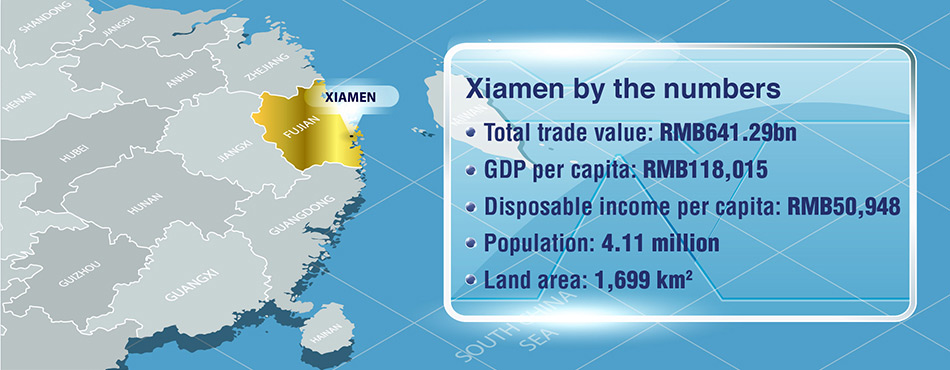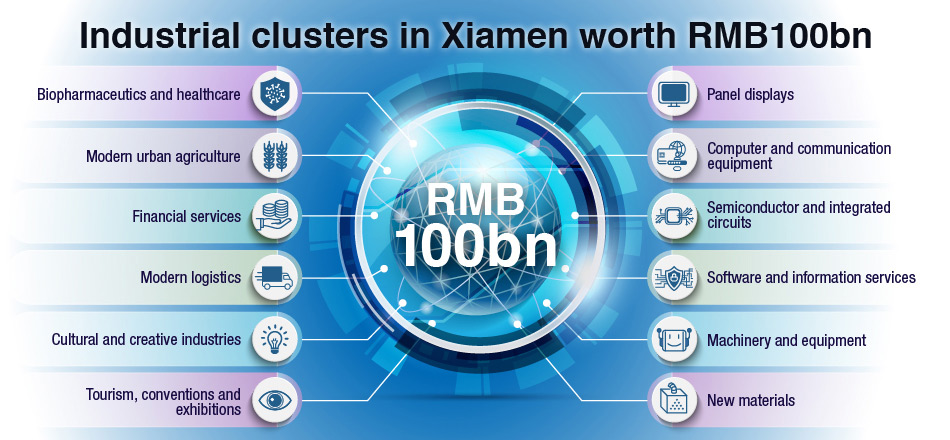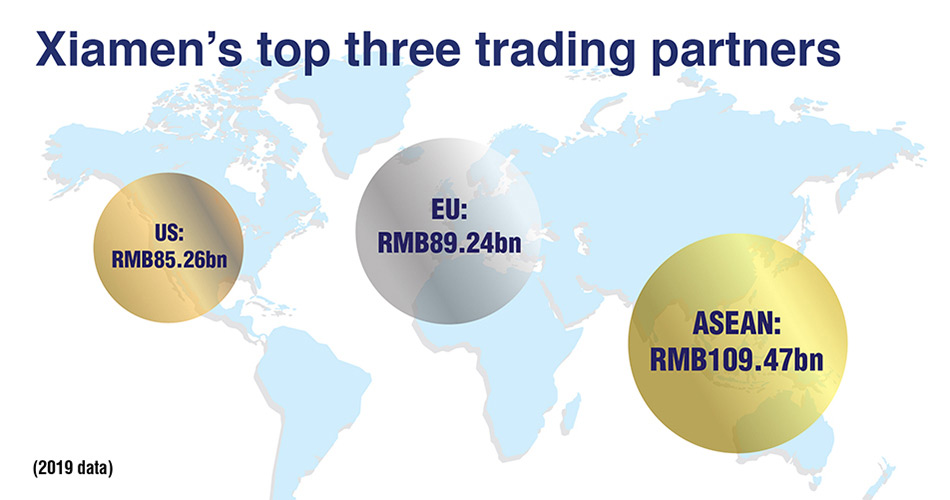As a global city featuring bustling ports and abundant tourism, Xiamen has now emerged as the strategic fulcrum of the Maritime Silk Road
Located on the west of the Taiwan Strait, Xiamen is a sub-provincial city of the Fujian Province and a city specifically designated in the state plan. The city covers an area of 1,699.39 square kilometres with a population of 4.11 million people. It was one of the first four Special Economic Zones that pioneered the reform and opening-up policies in Mainland China.
Dynamic development
Four decades of reform and opening-up have seen GDP in Xiamen grow at an average annual rate of 15.4 per cent, while that of government revenue is registered at 18.5 per cent. With much promise in innovation and entrepreneurship, Xiamen ranks top of the nation in terms of aggregate revenue, per capita GDP, per capita government revenue, and foreign trade competitiveness. High- and new- technology emerged as a core industry in the city, with nearly 70 per cent of industrial added value of above-scale enterprises coming from companies in this category. Xiamen is a top-tier international transport hub and one of the four international shipping centres in Mainland China. It is no wonder that it is considered one of the best cities in the country for entrepreneurship, ranking second among the pilot cities in Mainland China in ease of doing business.
Pioneering endeavours
Facing the ocean, Xiamen is naturally one of the points of departure of the 21st Century Maritime Silk Road. It boasts an outward facing economy brimming with bright prospects. As a national-level Special Economic Zone, Xiamen has a talented pool of professionals and advanced technology well-prepared to quickly grow its economy. The municipal government also makes great effort to create a first-class market-oriented economy and level playing field for enterprises to prosper.Advantageous location
- Xiamen faces the Taiwan Strait on the east and is connected to the Pearl River Delta and the Yangtze River Delta on the south and north, both of which are essential to the country’s economy.
- The Beijing-Kowloon Railway links Xiamen to the vast hinterlands of inland provinces such as Jiangxi, Hunan and Hubei.
- Xiamen is a hub that seamlessly connects different cities and regions along the Maritime and Land Silk Road. It plays an important role in strengthening exchanges in economic, cultural and human resources.
- Xiamen is the only special economic zone in Mainland China “established especially for Taiwan”. It looks to encourage cross-strait co-operation and stands as the gateway to the mainland for Taiwanese businesses.
- The Port of Xiamen connects to international shipping routes that cover 129 ports in 48 countries and regions.

Regional and international transportation hub
Xiamen’s geographical advantages and sound infrastructure guarantee swift transportation from the city to surrounding areas and far beyond.- Convenient air traffic: As one of the six major airports in Mainland China, Xiamen Airport now operates 171 air routes, including 35 international routes and six intercontinental routes, providing access to Australia, Canada, the Netherlands, the US and 28 international cities including Hong Kong, Macao, Taipei and Kaohsiung. Xiamen offers “144-hour visa-free transit” for travellers from designated countries.
- Developed shipping hub: Xiamen is one of Mainland China’s four major international shipping centres and is also a logistics centre in the southeastern part of the country. There are 146 container lines, including 92 international lines, of which 57 link up nations along the Maritime Silk Road. The Port of Xiamen has 165 berths, of which 76 have a capacity above ten thousand tonnes.
- Efficient transportation hub: Expressway and highway networks link Xiamen seamlessly with other transportation networks in the central and western parts of Mainland China. Augmented by railway networks, transportation time to Shanghai, Shenzhen and Fuzhou is shortened to five, three and two hours,
- China (Xiamen) – Europe train: Xiamen is the only land and sea transportation hub that connects “the Belt” and “the Road”. International freight trains to 12 countries and 34 cities in Europe, Central Asia and Russia are in operation.

Key industries
Based on local resources and designated functions, Xiamen focuses on developing five industrial clusters, including electronic information, equipment manufacturing, tourism, modern logistics and financial services. In order to improve comprehensive industrial competitiveness, the city strives to nourish more than 10 industrial clusters that are each worth RMB100bn. These include panel displays, computer and communication equipment, semiconductor and integrated circuits, machinery equipment, biopharmaceutics and healthcare, new materials, tourism, conventions and exhibitions, modern logistics, software and information services, financial services, cultural creativity and modern urban agriculture.
Trade performance
- In 2019, Xiamen recorded a total trade value of RMB641.29bn, representing a growth of 6.9 per cent and 48.2 per cent of Fujian Province’s total trade value, placing the city at the forefront of the province in terms of trade performance. While exports grew 5.7 per cent to RMB352.87bn, imports grew 8.3 per cent to RMB288.42bn.
- Xiamen’s imports from and exports to countries along the Belt and Road Initiative are also growing well. Imports and exports totalled RMB202.19bn, representing an increase of 14.4 per cent and accounting for 31.5 per cent of Xiamen’s total trade over the same period. The pace of market diversification is steadily advancing.
- The Philippines, Vietnam and Indonesia are Xiamen’s top three export partners, while the top three import partners are Indonesia, Malaysia and Vietnam. Imports from and exports to certain countries have recorded exceptionally strong growth, as seen in both imports from and exports to Oman that increased by 7.8 times, to Ukraine by double, and to Uzbekistan by 92.5 per cent.

- ASEAN, the EU and the US are the top three trading partners of Xiamen. In 2019, Xiamen’s imports from and exports to these three regions amounted to RMB109.47bn, RMB89.24bn and RMB85.26bn, respectively. During the same period, imports from and exports to these regions accounted for 44.3 per cent of Xiamen’s total trade value.
- Xiamen exported RMB169.25bn of mechanical and electrical products in 2019—an increase of 3.9 per cent—which accounted for nearly half of the export value. Exports of labour-intensive products remained robust. The city exported RMB119bn worth of textiles, clothing, footwear, toys, plastic products, bags and furniture, representing an increase of 12.2 per cent and accounting for 33.7 per cent of the city’s exports. In terms of imports, iron ore, coal, copper ore and other natural resources accounted for a relatively large proportion.
